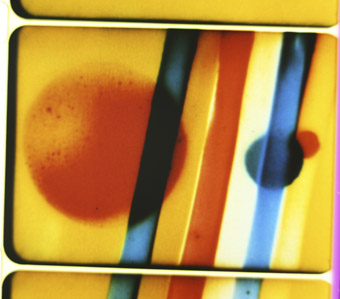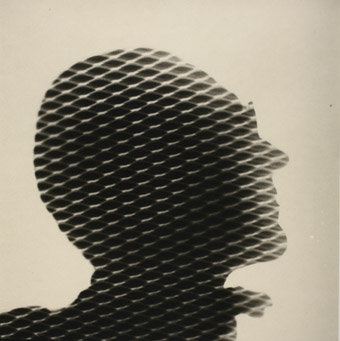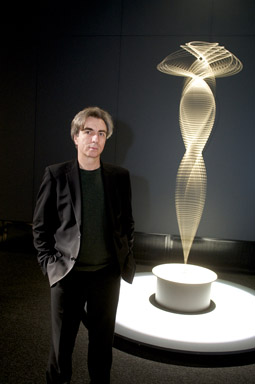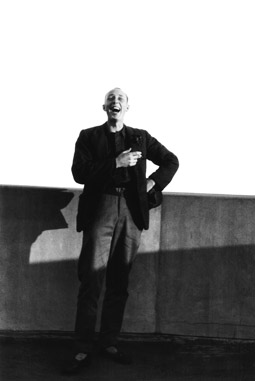figuring motion: a 20th century artist for the 21st
danni zuvela: len lye at acmi

film still from Colour Flight, 1938, Len Lye
courtesy of the Len Lye Foundation, the Govett-Brewster Gallery and the New Zealand Film Archive
film still from Colour Flight, 1938, Len Lye
THE AUSTRALIAN CENTRE FOR THE MOVING IMAGE’S NEW LEN LYE SHOW IS FRAMED—IN MORE WAYS THAN ONE—BY AN INSTALLATION RADIATING COLOURED LIGHT OVER THE ENTRANCE TO GALLERY 1. AN ENLARGED PANEL OF ILLUMINATED HAND-WORKED FILM, ITS DAZZLING DOTS AND DYNAMIC DIAGONALS ARE A PORTENT OF THE UR-FORMS CRISS-CROSSING THIS EXHIBITION, AND A PERFECT SYMBOL OF THE ARTIST’S LIFE-LONG QUEST TO “FIGURE MOTION.” THE CAREFUL PLACEMENT AT THE START OF THE VIEWER’S JOURNEY INDICATES THE THOUGHTFULNESS THAT HAS GONE INTO THE CURATION OF THIS SHOW, AND THE VISITOR’S CONSEQUENTLY RICH EXPERIENCE.
Assembled by senior ACMI curator Alessio Cavallaro and Tyler Cann of the Govett-Brewster Gallery and Len Lye Foundation the exhibition offers an unprecedented opportunity to experience this New Zealand-born artist’s remarkable oeuvre, which spans hand-made and ‘scratch’ filmmaking; animation, documentary and advertising films, painting, drawing, textiles, photography, poetry, and, spectacularly, kinetic sculpture.
Experience is a key word here: the visitor, guided on a tour through the mind of one of the 20th century’s greatest artists, is distinctly encouraged to respond to these works, aesthetically and intellectually, but also physically and intuitively. Across time and through a variety of media, the journey revisits key thematic refrains of figuring motion; Lye’s personal theories of “individual happiness now”; and stylised formal archetypes emanating from what he called the primitive “old brain.”
After passing the multi-coloured frame enlargement, the visitor enters the gallery’s first space, housing drawings, the artist’s famous ‘doodles’ and paintings. Not only are these confident works exceptionally well-preserved, they are arranged throughout the space so as to subtly guide the viewer from the artist’s early sketches, across the tools and other illuminating biographical ephemera, through batiks and paintings which, in turn, give way to the ‘sculpture garden’, featuring some of Lye’s most renowned kinetic sculptures. Three of these—Rotating Harmonic (1959), Zebra (1965) and Moon Bead (1968)—have been especially reconstructed for this major retrospective. Well-behaved (on my visits), a 16mm film projector runs film on a loop, bathing the inner space in golden flicker and underscoring the whole experience with another low, mechanical hum. Our eyes are led to Lye’s photograms (camera-less photographs created by directly placing materials onto film and exposing them) to his animation and advertising films, and back around through the sculpture garden’s spindly structures, until we finally come to the dark cave at the end housing the digitally-beamed scratch films.
The sculpture garden is a beautifully low-lit forest of gently swaying steel stems, sighing and whirring and reverberating, sprouting and shivering. A constant, complex strobe is created by the motion of these “tangibles”, as Lye called them, which carve the exhibition space up into the radial, fanning and spiralling shapes so characteristic of his work. Visible from most parts of the exhibition, and frankly amazing when you’re inside it, this weird womb is also the exhibition’s heart, and in some ways its brain centre, as it’s here that the show’s truly show-stopping magic happens. Motorised sculptures embark on performances at regular intervals (Lye had a very keen sense of the duration of his kinetic art). Huge but gentle, with stainless-steel rods fitted tightly into a socket like stems in a flower vase, a fountain of metal rods unfurls overhead like an enormous space-age bouquet. On one visit, I observe a group of adolescents stumble backward from Fountain III’s (1976) towering arms to get a better view, their expressions rapt, faces striped with intermittent light (I am amazed that they appear to be guardian-less, suggesting that a group of boisterous teenage boys came of their own accord to see a modern art show, but then again, this is Melbourne, and more importantly, this is Len Lye).

photogram, Le Corbusier, 1947, Len Lye
courtesy of the Len Lye Foundation and the Govett-Brewster Art Gallery
photogram, Le Corbusier, 1947, Len Lye
In contrast to the Fountain’s gentle swathes, Blade (1959-1976) begins as a cork ball on a springy stem setting up a light, rhythmic tapping on a length of steel. Not unlike a rectangular saw, Blade’s ‘receiving’ element begins to wobble, at first gently, then with increasing violence and sonority. As the pounding becomes more urgent, the blade buckles, complains and resonates, setting up a deep wave that ricochets throughout the room and seems to pass through my sternum each time. As the sculpture’s motions become more frenzied, and the blade is bent forward by progressively more explosive thrusts, I can’t help sneaking a peek at the transfixed teens to see if they are clued into this evidently erotic undulation. (Yes, they are). Their blushing sniggers are soon joined by the knowing chortles and outright belly laughs of other patrons. At the culmination of Blade’s performance, as ball and blade slowly return to resting state, there is one of those precious group moments that sometimes happens in the temporary community of an art gallery, as everyone simultaneously lets out an embarrassed cough and disperses abruptly. Fortunately, there’s a nearby escape into the sanctity of the scratch films in the screening room.
With Lye’s handmade films, the eyes are bombarded with “waves, stripes, blobs of violent tints, suggesting tartan, bandanna, boarding house wallpaper, fruit salad, chromatic spaghetti and an explosion in a cocktail bar” (as a reviewer in London’s Daily Mail said on the release in 1935 of A Colour Box). While the film work remains as mesmerising as ever, for many visitors who may be familiar with this, the show’s real enchantment is the way those same formal concerns are expressed across different materials and media. Lye’s practice is rigorously, even obsessively consistent: the same sensual, swirling, fraying, spraying, spreading shapes recur in paint, stencilled or incised onto film, doodled over paper, and given breathtaking mechanical form in the tangibles. The curators’ careful selection and juxtaposition of Lye’s work in the show establishes a sympathetic space for conversation between these works, enabling viewers to draw their own connections between his forms, obsessions and commanding achievements.
Biographer Roger Horrocks’ informative lecture highlights Lye’s artistic interest in notions of empathy, making it especially obvious that the ACMI exhibition too revolves around this concern with, and also within, Lye’s multiform practice. Cavallaro modestly agrees that “as curators, we spent time trying to really empathise with his work, thinking about ways to hopefully yield the most sympathetic resonance with the viewer.
“This was a somewhat tricky thing to do as, of course, Lye worked across so many mediums, and there was such a range of expression. So we thought what we would do was to try to present the work as sections, each self-contained, yet interrelated with others and able to be experienced in an integrated way. We could really ‘open up’ the work, and reveal his approaches and, invariably, connections between mediums. To do so in a way that is not didactic, more in a way that enables the visitor to experience this work on a more intimate and more personal scale, was our challenge.”
The question of the appropriate empathetic arrangement of the array of materials preoccupied much of the curators’ time in the exhibition’s planning. Tyler Cann first encountered Lye as a young art student under the influential modern art historian-critic, Yves Alain Bois, whose promotion of Lye opened the young scholar’s eyes to kinetic art developments beyond the Euro-American sphere. Cavallaro was first exposed to Lye’s work through the extraordinary scratch films, marvelling at their dynamic synchronisation and, he says, “totally captivated by their elegant simplicity; the less is more approach.”

Alessio Cavallaro with Len Lye’s Zebra, 1965
photo Nolan Bradbury
Alessio Cavallaro with Len Lye’s Zebra, 1965
When I ask if he was tempted to foreground the films more, he agrees that the films are “bewitchingly beautiful” and that ACMI “could have zoomed in on that aspect alone, and it would have been fascinating—there are easily enough films by Lye that could fill Gallery 1.” However, as Cavallaro puts it, “Lye’s such a polymath, such a multimedia artist, such an artist of the 21st century—in other words, very much a contemporary artist, exploring a range of media—that the show wouldn’t have done him justice as an artist if just focused on the films.”
In particular, Cavallaro says, there was a pressing need to explore “Lye’s motion ideas with great intensity: how he applied them, how he experimented with them, and ultimately how he presented his notions of composing with motion.” To do this meant an emphasis on the “obvious connections between one medium and another, direct connections between all the work, cross currents and cross energies reverberating throughout the space. That’s one reason why we have the scratch films at the end of the journey.”
The beat of African drums from the seminal, much-loved Free Radicals (1958) is deliberately allowed to seep through and affect—or more correctly, infect—the gallery space with its urgent, primal rhythms. Len Lye would have loved this, I’m sure; he said he wanted to ensure that “the shoulder blades and thigh sinews of the gallery-goer got the resonant message” his work communicates. On seeing these “white ziggle-zag-splutter scratches on black 16mm film…in quite doodling fashion” (Lye), the visitor, everywhere constantly reminded of the kineticism of the human body, is virtually impelled to move (fortunately there is lots of space in the screening room!). This little cinema provides a dedicated space for the absorbed contemplation of these works, a fitting conclusion to the exhibition’s dazzling trip through the artist’s life and work.

Len Lye in Sydney
photo Mary Brown. Image courtesy of the Len Lye Foundation and Govett-Brewster Art Gallery
Len Lye in Sydney
“As you leave the exhibit”, Cavallaro advises, “as you’re going up the escalator to exit, look back over your shoulder at the show and see what that different view does for you.” I did, as others should, for the ultimate conclusion to the journey: as you ascend and the show recedes, the birds-eye view reveals the topography of an amazing little universe—a kaleidoscopic Lye-land—pulsing and dancing and in a mosaic of swaying steel, light and sound.
ACMI, Len Lye, curators Alessio Cavallaro, Tyler Cann, presented by the Australian Centre for the Moving Image in collaboration with the Govett-Brewster Art Gallery (New Plymouth, New Zealand), and with the support of The Len Lye Foundation and the New Zealand Film Archive; ACMI, Melbourne, July 16-Oct 11; www.acmi.net.au/len_lye.aspx
RealTime issue #92 Aug-Sept 2009 pg. 26






